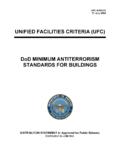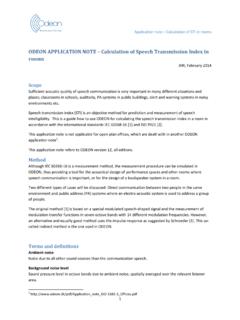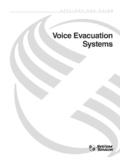Transcription of THE MEASUREMENT OF SPEECH INTELLIGIBILITY
1 THE MEASUREMENT OF SPEECH INTELLIGIBILITY . Herman Steeneken TNO Human Factors, Soesterberg, the Netherlands 1. INTRODUCTION. The draft version of the new ISO 9921 standard on the Assessment of SPEECH Communication . defines SPEECH INTELLIGIBILITY as: a measure of effectiveness of understanding SPEECH . This contribution describes and compares several of these measures for determining the INTELLIGIBILITY of a given SPEECH transmission system. It may include the acoustical environment at the speaker and the listener position. In general two principally different assessment methods may be applied: (1) Subjective assessment, based on the use of speakers and listeners, (2) Objective assessment based on physical parameters of the transmission channel.
2 For a representative estimate of the SPEECH INTELLIGIBILITY at least four speakers and four listeners are required, thus 16 speaker listener pairs. This results in a laborious effort. As the results depend on the individual subject responses, a reproduction of the test results in not obvious and requires at least inclusion of a number of reference conditions. Objective measurements do not measure INTELLIGIBILITY but determine physical parameters to predict INTELLIGIBILITY according to a certain model. One should be aware that such a model might have restrictions that should be considered. 2. SUBJECTIVE INTELLIGIBILITY ASSESSMENT.
3 First of all SPEECH INTELLIGIBILITY should not be confused with SPEECH quality. SPEECH INTELLIGIBILITY is related to the amount of SPEECH items that is recognized correctly while SPEECH quality is related to the quality of a reproduce SPEECH signal with respect to the amount of audible distortions. The subjective INTELLIGIBILITY measure might be based on phonemes, words (these may be meaningful words or nonsense words), and sentences. In principle there is a fixed relation between these three different types of SPEECH material. However, although there are conditions where it is much more easily to detect a meaningful word ( , a digit or the alphabet) than a nonsense word that consists of a random combination of a consonant, vowel, and consonant (so- called CVC-word).
4 Various techniques for the presentation of the test material to the subjects and of the type of response are used. With the presentation of test words it is required to embed these words into a carrier phrase. This has the advantage that: the speaker can control his vocal effort, the listener is attended that a test word has to be recognized, and in case of temporal distortion (reverberation, echoes, and automatic gain control) a representative condition with respect to continuous SPEECH is obtained. The response method might be open or closed. An open response allows the listener to respond to what he/she thinks to have heard.
5 A closed response offers the listener some alternative from which a selection has to be made. This is the case with the modified rhyme test (House et all, 1965) where the listener has to select an initial consonant or a vowel from a group of six alternatives, even if a phoneme outside the alternative list is recognized. This is especially the case with the Diagnostic Rhyme Test (DRT) which is based on only two alternatives (Voiers, 1977). A closed response paradigm has the advantage that only a simple learning session of the listeners is required, while an open response, especially used with nonsense words, requires extensive training.
6 However, the open response test has the advantage that better discrimination between various transmission conditions is obtained (increased effort pays off). A confusion matrix of the phonemes can be obtained from the scores in case nonsense words with an equally balanced distribution of the phonemes are used. In general a word list is compiled based on a representative selection of initial consonants (Ci), vowels (V), and final consonants (Cf ). For the Dutch test 17 initial consonants, 15 vowels and 11 final consonants are used. Word tests provide both word scores and individual phoneme scores, rhyme test are restricted to phoneme scores with a limited set of alternatives.
7 For tests with sentences various scoring methods are used. Frequently used is the Mean Opinion Score (MOS) where subjects (minimal 16) are asked to score their impression of the INTELLIGIBILITY on a five point scale. This scale amounts bad, poor, fair, good, and excellent. The MOS is often used for telecommunication assessment (telephone, GSM, etc). A very reproducible test, based on sentence INTELLIGIBILITY provides the SPEECH Reception Threshold (SRT). For the SRT a sentence that is masked by noise, is presented to a listener. The listener has to recall the sentence precisely. If the listener produces a correct answer, the next sentence is presented with an increased noise level of 2 dB.
8 This continues till the response of the subject is incorrect, than the noise level will be decreased by 2 dB. After a number of presentations, a noise level is obtained for which 50 % of the sentences are responded correctly. The test amounts 13. sentences, the first three sentences guide the listener to the threshold, the noise levels used with the presentation of the last 10 sentences is used to obtain the SRT. The higher the INTELLIGIBILITY of the original SPEECH the more noise can be added for the 50% correct responses (Plomp and Mimpen, 1979). In Fig 1 the relation between consonant and vowel scores are given for 78 conditions.
9 The conditions are based on three signal-to-noise ratios (0, , and 15 dB) and 26 band pass conditions. The scatter diagram clearly indicates that a high vowel score can be obtained with a low consonant score en visa versa. Therefore it is recommended to use test material based on both consonants and vowels. Some tests are only based on consonants such as the Diagnostic Rhyme Test (DRT, Voiers, 1977) and the articulation loss of consonants (Alcons , Peutz 1971). As these tests are normally used within a limited area of applications (DRT for SPEECH coders, and Alcons in room acoustics). there might be a unique relation with results obtained in similar conditions.
10 However, for application in a wider range of distortions there might be a different relation for each field of application and no unique criteria can be applied. 100. 80. vowel score (%). 60. 40. 20. 0. 0 20 40 60 80 100. initial-consonant score (%). Fig. 1 Relation between consonant and vowel score for 78 conditions based on three signal-to- noise ratios and 26 bandwidth limitations. In Fig. 2 a qualification and the relation between various subjective INTELLIGIBILITY scores and the subjective STI ( SPEECH Transmission Index) is given. The qualification intervals are also related to a specific SPEECH -to-noise ratio for a noise with a frequency spectrum equal to the SPEECH spectrum.









